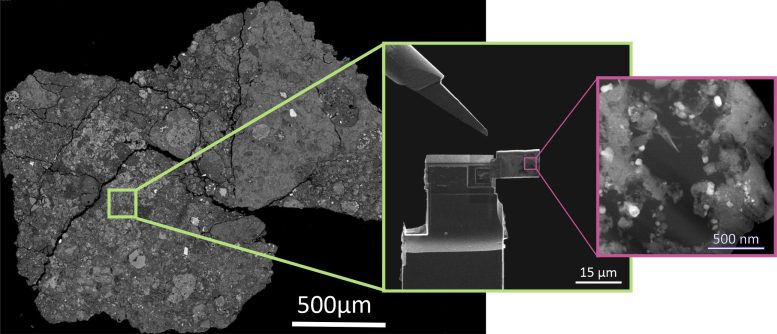[ad_1]

Meteorites, remnants of asteroids, are essential for understanding our photo voltaic system’s historical past, appearing as time capsules that protect primordial materials. Researchers have made a groundbreaking discovery within the Winchcombe meteorite, figuring out key nitrogen compounds, together with amino acids and hydrocarbons, with out chemical remedies, utilizing a novel detector design. This discovering, vital for analysis into life’s origins on Earth, was facilitated by a high-resolution electron microscope on the SuperSTEM laboratory. This system not solely enhances our understanding of meteorites but in addition holds potential for analyzing extraterrestrial specimens from house missions.
A analysis crew has analyzed extraterrestrial amino acids and different natural compounds in an English meteorite fall for the primary time with out utilizing any chemical remedies.
Meteorites are fragments of asteroids which discover their technique to Earth as taking pictures stars. These cosmic sediments have frozen the primordial soup from which our photo voltaic system emerged – preserving it identical to a time capsule. These rocks assist researchers to resolve the origins of matter and of life on Earth. Working along with British colleagues, Dr. Christian Vollmer from the Institute of Mineralogy at Münster College has examined certainly one of these time capsules, and a really particular one – the Winchcombe meteorite.
The crew of researchers at the moment are the primary to display, to a excessive diploma of precision, the existence of some necessary nitrogen compounds on this meteorite with amino acids and heterocyclic hydrocarbons – with out making use of any chemical therapy, and by utilizing a brand new sort of detector design. The outcomes have been revealed within the journal Nature Communications.
The Winchcombe Meteorite
The Winchcombe meteorite was noticed by a digital camera community in England in February 2021, and it was collected inside only a few days. “Usually, meteorites are tracked down in the cold and warm deserts on Earth, the place the dry local weather signifies that they don’t climate very quick, however they do change on account of humidity,” says Christian Vollmer. “If a meteorite fall is noticed quickly after the occasion and the meteorite is rapidly collected, as was the case in Winchcombe, they’re necessary ‘witnesses’ for us concerning the beginning of our photo voltaic system – which makes them particularly fascinating for analysis functions.”

Utilizing a nanomanipulator and an ultra-fine ion beam, a tiny lamella, about 5 by ten micrometres in dimension and just one hundred nanometres skinny, is minimize out of the meteorite and connected to a pattern bar. The scientists can then analyze the natural particles on this lamella below an electron microscope (proper). Credit score: SuperSTEM Laboratory, Daresbury, UK
Origins of Life and Superior Analysis Methods
The origins of life on our planet are nonetheless shrouded in thriller, and a few researchers assume that the primary biologically related matter was transported to Earth in meteorites over 4 billion years in the past. This matter consists of for instance complicated natural compounds corresponding to amino acids or hydrocarbons. Nonetheless, these molecules have solely very low concentrations, and the specialists typically must separate them out from the meteorite by utilizing solvents or acids after which enrich them for analytical functions.
Christian Vollmer’s crew was now the primary to have the ability to display the existence of those biologically related nitrogen compounds within the Winchcombe meteorite with out first treating them chemically – though right here too the concentrations of those substances are very low.
Of their work, the researchers used a contemporary, high-resolution electron microscope corresponding to is discovered at only some places worldwide. This “super-microscope” on the SuperSTEM laboratory in Daresbury in England not solely depicts high-carbon compounds at atomic decision – it could possibly additionally analyze the samples chemically by the use of a brand new sort of detector.
“Demonstrating the existence of those biologically related natural compounds in an untreated meteorite is a big achievement for analysis,” says Vollmer. “It reveals that these constructing blocks of life could be characterised in these cosmic sediments even with out chemical extraction.” The event can also be of nice significance as a result of chemical therapy consists of the danger of those fragile substances being modified.
For this reason the analytical strategies utilized right here to stable matter are probably additionally worthwhile for analysis on small, extraterrestrial specimens introduced again to Earth from house missions – such because the mud particles from asteroids lately introduced again by the Japanese House Company (Hayabusa2) and NASA (OSIRIS-REx).
Reference: “Excessive-spatial decision practical chemistry of nitrogen compounds within the noticed UK meteorite fall Winchcombe” by Christian Vollmer, Demie Kepaptsoglou, Jan Leitner, Aleksander B. Mosberg, Khalil El Hajraoui, Ashley J. King, Charlotte L. Bays, Paul F. Schofield, Tohru Araki and Quentin M. Ramasse, 26 January 2024, Nature Communications.
DOI: 10.1038/s41467-024-45064-x
[ad_2]
Supply hyperlink

